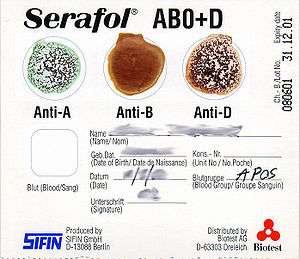Agglutination (biology)
Agglutination is the clumping of particles. The word agglutination comes from the Latin agglutinare (glueing to).
Agglutination occurs if an antigen is mixed with its corresponding antibody called isoagglutinin. This term is commonly used in blood grouping.
This occurs in biology in three main examples:
- The clumping of cells such as bacteria or red blood cells in the presence of an antibody or complement. The antibody or other molecule binds multiple particles and joins them, creating a large complex. This increases the efficacy of microbial elimination by phagocytosis as large clumps of bacteria can be eliminated in one pass, versus the elimination of single microbial antigens. Another example occurs when people are given blood transfusions of the wrong blood group.
- The coalescing of small particles that are suspended in a solution; these larger masses are then (usually) precipitated.
Agglutination in hematology
Hemagglutination

Hemagglutination is the process by which red blood cells agglutinate, meaning clump or clot. The agglutin involved in hemagglutination is called hemagglutinin.
In cross-matching, donor red blood cells and recipient's serum or plasma are incubated together. If agglutination occurs, this indicates that the donor and recipient blood types are incompatible.
Leukoagglutination
Leukoagglutination is when the particles involved are white blood cells.
An example is the PH-L form of phytohaemagglutinin.
Agglutination in microbiology
Agglutination is commonly used as a method of identifying specific bacterial antigens, and in turn, the identity of such bacteria. Because the clumping reaction occurs quickly and is easy to produce, agglutination is an important technique in diagnosis.
History of discoveries
Two bacteriologists, Herbert Edward Durham (-1945) and Max von Gruber (1853–1927), discovered specific agglutination in 1896. The clumping became known as Gruber-Durham reaction. Gruber introduced the term agglutinin (from the Latin) for any substance that caused agglutination of cells.
French physician Fernand Widal (1862–1929) put Gruber and Durham's discovery to practical use later in 1896, using the reaction as the basis for a test for typhoid fever. Widal found that blood serum from a typhoid carrier caused a culture of typhoid bacteria to clump, whereas serum from a typhoid-free person did not. This Widal test was the first example of serum diagnosis.
Austrian physician Karl Landsteiner found another important practical application of the agglutination reaction in 1900. Landsteiner's agglutination tests and his discovery of ABO blood groups was the start of the science of blood transfusion and serology which has made transfusion possible and safer.